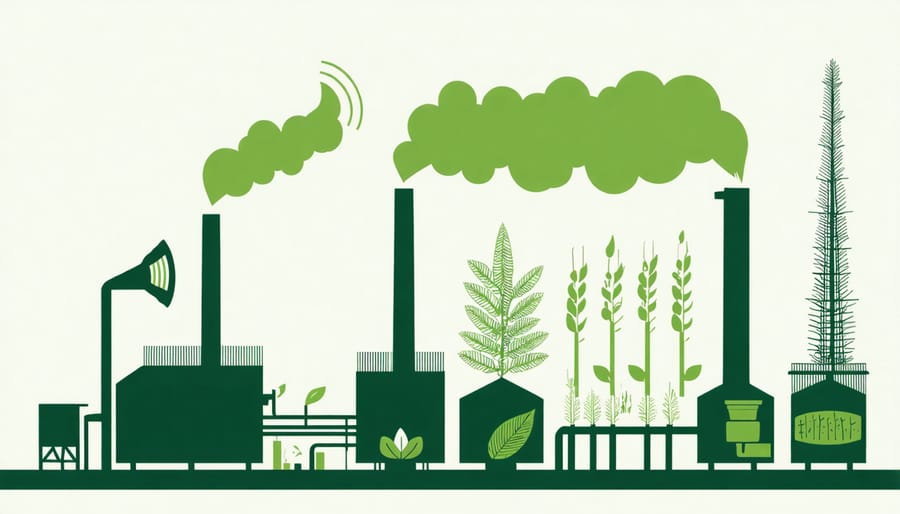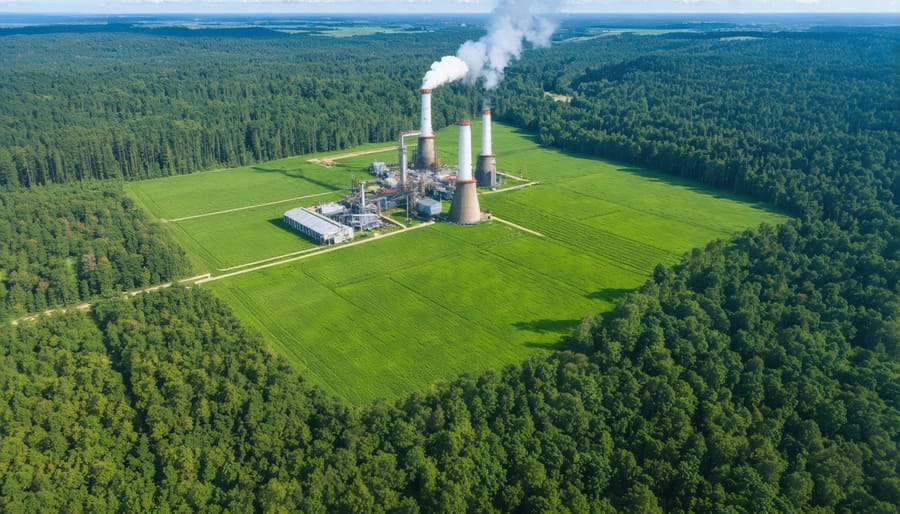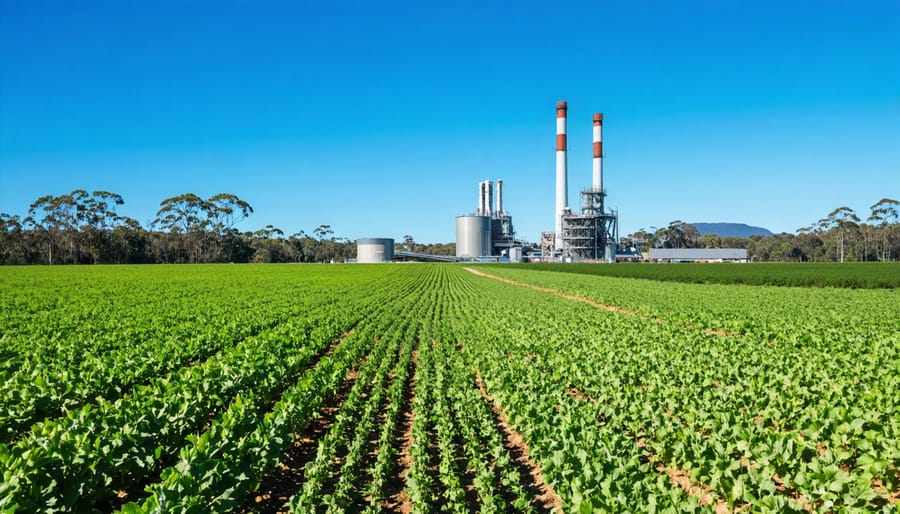Bioenergy, a renewable energy derived from organic matter, is poised to revolutionize Australia’s sustainable future. As the nation grapples with climate change and seeks cleaner alternatives to fossil fuels, bioenergy emerges as a compelling solution. By harnessing the power of bioenergy resources such as agricultural waste, forestry residues, and purpose-grown crops, Australia can reduce greenhouse gas emissions, bolster energy security, and stimulate regional economies. This article explores the potential of bioenergy as a renewable energy source, its environmental benefits, and its role in shaping a more sustainable and resilient Australia.
How Bioenergy Works
Biomass Sources
Bioenergy can be produced from a diverse range of biomass feedstocks, making it a versatile renewable energy option. Agricultural waste, such as crop residues and animal manure, is a readily available source that can be converted into biofuels or biogas. Forestry residues, including wood chips and sawdust from timber processing, are another valuable biomass resource. Additionally, dedicated energy crops like switchgrass and miscanthus can be grown specifically for bioenergy production. By utilizing these various feedstocks, we can harness the power of organic matter to generate clean, renewable energy while reducing waste and supporting sustainable land management practices.
Conversion Technologies
Several technologies convert biomass into energy. Direct combustion burns organic materials to produce heat and electricity. Gasification partially oxidizes biomass at high temperatures, creating syngas for power generation or fuel production. Anaerobic digestion uses microorganisms to break down organic waste, producing biogas rich in methane. This biogas can power vehicles or generate electricity. Fermentation converts plant sugars into ethanol, a renewable transport fuel. Bioenergy technologies transform organic waste and purpose-grown crops into clean, renewable energy, helping Australia transition to a sustainable future.

Bioenergy’s Environmental Benefits
Carbon Neutrality
When properly managed, bioenergy can be a carbon-neutral energy source. During photosynthesis, plants absorb carbon dioxide (CO2) from the atmosphere as they grow. When these plants are later used for bioenergy production, such as burning biomass or converting it into biofuels, the CO2 released during combustion is offset by the amount previously absorbed. This creates a closed carbon cycle, where the net CO2 emissions are essentially zero. However, to ensure true carbon neutrality, the biomass must be sourced from sustainably managed crops or waste materials, and the energy used in production and transportation should also come from renewable sources. When these conditions are met, bioenergy offers a promising solution for reducing greenhouse gas emissions and combating climate change in Australia and beyond. By embracing carbon-neutral bioenergy, we can work towards a cleaner, more sustainable future for generations to come.

Waste Reduction
Using waste biomass for energy production offers a sustainable solution to minimize landfill waste and its associated environmental impacts. When organic waste decomposes in landfills, it releases methane, a potent greenhouse gas contributing to climate change. By diverting this waste to bioenergy facilities, we can significantly reduce methane emissions while generating renewable energy. In Australia, innovative projects are transforming agricultural and food waste into valuable bioenergy, demonstrating the potential to tackle waste management challenges and support the transition to a circular economy. Embracing waste-to-energy solutions not only mitigates the environmental burden of landfills but also creates new opportunities for sustainable resource management and energy security.
Applications of Bioenergy in Australia
Electricity Generation
Biomass power plants play a crucial role in generating renewable electricity for Australian homes and businesses. By harnessing the energy stored in organic materials, such as agricultural waste, wood chips, and dedicated energy crops, these facilities provide a sustainable alternative to fossil fuels. The process involves burning biomass to produce steam, which drives turbines to generate electricity. This technology is not only renewable but also helps reduce greenhouse gas emissions by recycling carbon dioxide absorbed by plants during their growth. As Australia continues to embrace clean energy solutions, biomass power plants are becoming an increasingly important component of the country’s renewable electricity mix, contributing to a greener future for all.
Industrial Uses
Bioenergy has the potential to revolutionize various industries in Australia, offering a sustainable solution to energy needs. In agriculture, bioenergy can be generated from crop residues, animal waste, and dedicated energy crops, reducing reliance on fossil fuels while supporting local farmers. The forestry sector can utilize wood waste and residues to produce bioenergy, creating a circular economy and minimizing waste. Manufacturing industries can harness bioenergy to power their operations, reducing greenhouse gas emissions and improving their environmental footprint. By embracing bioenergy, these industries not only contribute to Australia’s renewable energy targets but also enhance their own sustainability and competitiveness in an increasingly eco-conscious market.
Biofuels for Transportation
Biofuels, such as ethanol and biodiesel, offer a promising solution for reducing the carbon footprint of Australia’s transportation sector. By using renewable feedstocks like sugarcane, wheat, and used cooking oil, these fuels can significantly lower greenhouse gas emissions compared to fossil fuels. Ethanol blends, such as E10, are already available at many Australian petrol stations, providing an easy way for drivers to reduce their environmental impact. As the government sets ambitious targets for zero carbon dioxide emissions by 2050, expanding the use of biofuels in transportation will play a crucial role in achieving a more sustainable future for Australia.
Challenges and Opportunities
Current Limitations
Despite the numerous benefits of bioenergy, there are some current limitations that need to be addressed. One challenge is the limited infrastructure for collecting, transporting, and processing biomass feedstocks. This can make it difficult to scale up bioenergy production and increase its adoption. Another issue is the high initial costs associated with setting up bioenergy facilities, which may deter some investors or organizations from pursuing this renewable energy option. Additionally, there is competition for land use between biomass production and other important activities like food agriculture and conservation efforts. Balancing these competing interests is crucial to ensure that bioenergy development is sustainable and does not negatively impact other vital land uses. However, with continued research, investment, and smart policymaking, these limitations can be overcome, allowing Australia to harness the full potential of this promising renewable energy source.
Future Potential
The future of bioenergy in Australia is bright, with government incentives, technological advancements, and increased public awareness driving its expansion. The Australian Renewable Energy Agency (ARENA) is investing in innovative bioenergy projects, such as converting sugarcane waste into renewable fuel. Cutting-edge technologies like advanced gasification and pyrolysis are making bioenergy more efficient and cost-effective. As more Australians recognize the environmental and economic benefits of bioenergy, demand for sustainable solutions will grow. With ongoing research and development, bioenergy has the potential to play a significant role in Australia’s transition to a clean energy future, creating jobs, reducing emissions, and enhancing energy security.
Conclusion
In conclusion, bioenergy stands out as a promising renewable solution that can help Australia transition towards a more sustainable future. By harnessing the power of organic materials, we can reduce our reliance on fossil fuels, lower greenhouse gas emissions, and support local economies. As we’ve seen, bioenergy projects across the country are already making a positive impact, from powering homes to creating jobs. However, to fully realize the potential of bioenergy, we must continue to invest in research, development, and infrastructure. By embracing this renewable energy source and working together to overcome challenges, Australia can lead the way in building a cleaner, greener future for generations to come.

